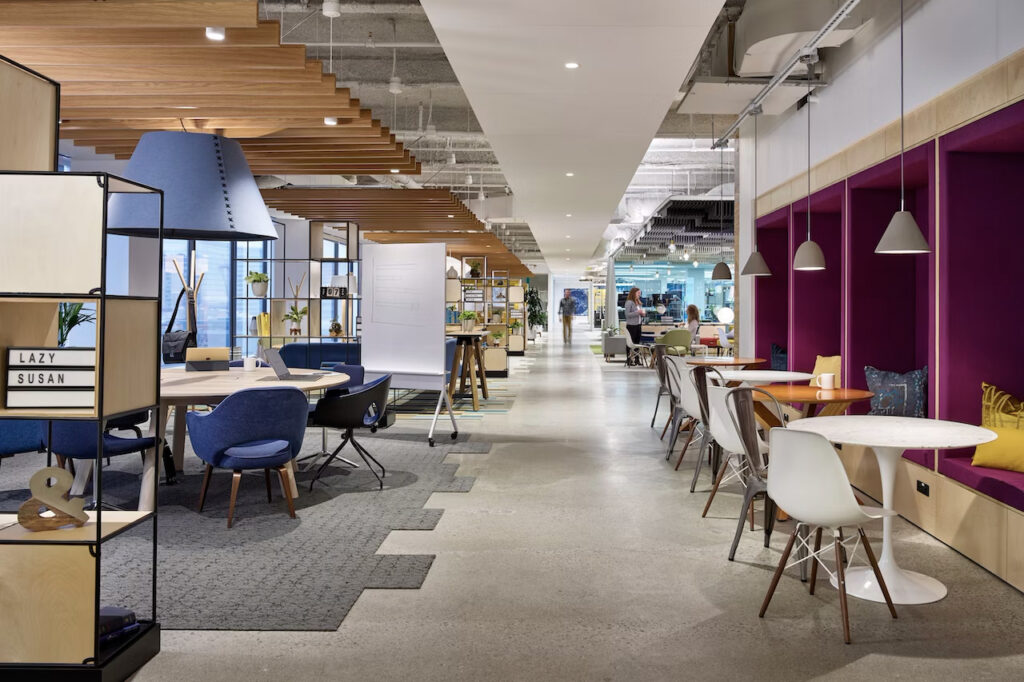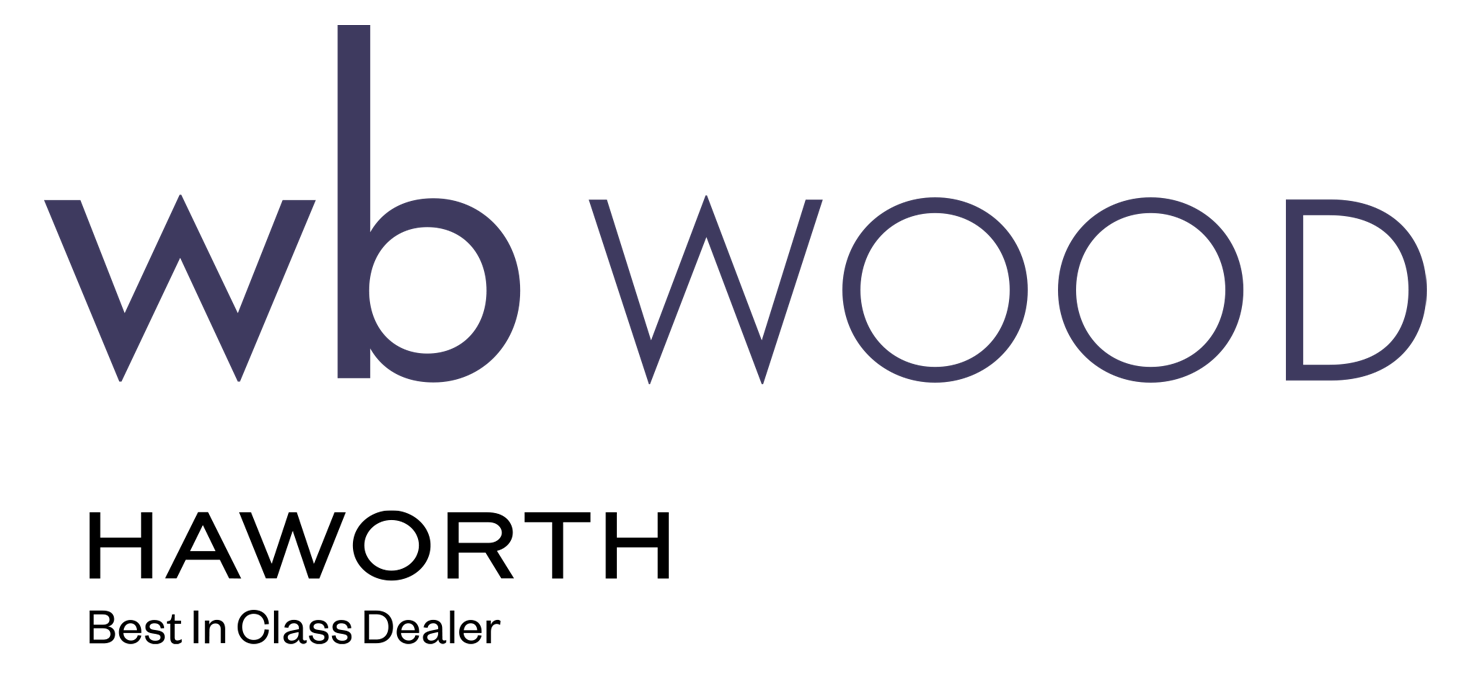Office Color Psychology

Many artists, designers and psychologists recognize color as a powerful tool that influences our moods, behaviors and physiological reactions. It makes sense, then, that the colors you use around your office have a significant impact on productivity, efficiency and creativity. Because every color evokes different emotions, you want to choose office colors that encourage positive emotions and stay true to your brand identity.
Getting workplace color psychology right via design elements like wall colors, furniture and artwork can be crucial to your business’ success and bring benefits such as improved culture and employee engagement. Continue reading to learn how workplace colors affect collaboration, productivity, creativity and well-being.
What Is Color Psychology?
Color psychology is the study of how colors influence our psychological responses and how factors like age and cultural background affect our reactions to color. Scientists in color psychology studies also observe how colors might have different meanings and connotations.
Other topics studied in this area include:
- Emotional responses to color.
- Factors that affect color preferences.
- How colors impact physiological responses.
- How colors can influence behaviors.
- Whether colors can influence mental health.
- How color affects productivity.
- How colors boost well-being.
- How colors can be used to improve design and safety in work and home settings.
The study of color psychology began during the early 20th century when Swiss psychiatrist Carl Jung examined the effects of color on the mind. Jung eventually developed color therapy, encouraging his patients to express themselves using colors and images.
Exploring Color Psychology in the Workplace
In older cultures, colors were often used to treat specific conditions and influence human behavior. They also played a role in spiritual practices. Today, color psychology is primarily used in marketing and advertising. Since some scientists believe colors subconsciously influence our emotions, they believe that they can influence our decisions, moods and actions. Colors are used in retail settings to encourage people to buy products or feel a certain way about a brand. For instance, sale signs are often red to convey a sense of urgency to influence customers to make impulsive purchases.
But how is color used in the workplace, and what is the impact of color on employee mood and feelings? Office color psychology is the art of consciously implementing colors in interior design to influence emotions, perceptions and actions. It is an important consideration when designing workspaces and requires diving into the depths of how color affects productivity and boosts employees’ moods.
Color’s Role in Employee Well-Being and Office Design
Workplace color psychology is a powerful tool interior designers use when designing office spaces. Designers are tasked with choosing the colors that create an inviting, comfortable and positive work environment that employees enjoy spending their days in. The best office colors should help employees manage anxiety and stress, enhance productivity, and increase focus and concentration.
While the way we perceive color is influenced by factors like gender, age and culture, some colors have a universal meaning. There are the two primary color categories that are distinguished based on their psychological effects: warm and cool colors. Warm colors, such as red, orange and yellow, are associated with positivity, energy and excitement. However, when used aggressively, they might evoke feelings of anger and frustration. Cool colors, such as blue, green and purple, are associated with feelings of calm, relaxation and focus.
Also important to mention are neutral colors like white and gray. These can be either warm or cool, depending on their undertones. For example, the Pantone color of the Year 2024, Peach Fuzz 13-1023, is a warm color with a cool undertone. It’s neutral, nurturing and subtly sophisticated.
Peach Fuzz 13-1023 is ideal for workspaces. Its sweet blend of pink and orange is warm enough to boost productivity and create a feeling of belonging, community and collaboration. At the same time, the color is cool enough to evoke feelings of wellness, awaken peace and nurture the soul, body and mind.
Harnessing Creativity and Productivity Through Color in the Workplace
The brief introduction to color psychology and the impact of color on workers’ moods and feelings above proves that you must be intentional about the colors you use around your office. Different colors inspire different feelings in employees, from increased creativity and productivity to decreased stress. Some colors may even promote office collaboration.
Below, we look at the effect of different colors on productivity at work. We’ll cover how light and color influence an office and how employees perceive different workplace colors.
Red
Red is typically associated with boldness and confidence. When used in the workplace, the color red evokes passion and energy and stimulates thinking. It also adds warmth to spaces, which makes it perfect for energizing workers in high-activity organizations.
However, too much red in the workplace might be overpowering and lead to strong emotions like anger or frustration. Therefore, red should be incorporated sparingly in the office, such as on accent furniture in conference rooms when you want to encourage passion and excitement. Going big with red in the workplace may be overstimulating and overpowering.
Blue
Blue is a well-rounded color that symbolizes reliability and may encourage intellectual thought. Researchers believe blue in an office will promote a calm and stable environment, helping employees stay productive and focused throughout the workday. Additionally, the tranquility evoked by the color blue also boosts their creative juices. Blue projects a sense of stability and reliability, which makes it perfect for use in reception areas to create a positive first impression with clients and employees.
You might also incorporate blues in areas such as meeting rooms to stimulate collaboration and productivity. Keep in mind that darker shades of blue can invoke feelings of sadness, while very cool shades of blue may make a room feel “cold” and uninviting.
White
White is perceived as a clean, fresh and modern color. Painting a workspace white invokes feelings of spaciousness because it adds the illusion of length to the floors and ceilings and extra width to the walls. It also helps make cramped or dark offices brighter and more inviting. You can also use white in open meeting areas, lobbies or collaborative spaces to create harmony and safety.
If you choose to paint your walls white, we recommend incorporating other warm colors to keep your office space inviting and warm. You can decorate an accent wall with your brand colors or add brightly colored furniture pieces to achieve a level of balance.
Black
In office color psychology, black can signify control and power. It is also often associated with luxury and elegance and evokes feelings of formality, professionalism and seriousness. However, it’s best to use black sparingly since it can absorb natural light. Using it as an accent to complement other colors can help you strike a balance between luxury and comfort. Some of the ways you can incorporate black in the workspace are on furniture, wall art, decor pieces and light fixtures.
Green
Green is a soothing color, often linked with the balance of the mind, body and emotions. Like blue, green is a color associated with creativity and productivity, making it an excellent choice for office spaces. You can incorporate green by bringing plants into the workplace, painting an accent wall or purchasing green furniture.
When looking for ways to include green in your workspace, consider creating a biophilic office. This is the concept of bringing the indoors inside by incorporating various elements of nature, such as potted plants, and ensuring maximum natural light and fresh air in the workspaces. A biophilic office space improves employee well-being and boosts productivity while minimizing stress levels.
Yellow
Splashes of yellow throughout the workplace evoke feelings of happiness, positivity and optimism, therefore boosting creativity and motivation while encouraging teamwork. Yellow is perfect for meeting rooms, training rooms and communal spaces where employees come together to brainstorm and strategize. It’s also a great accent color when paired with cool and neutral colors.
However, researchers also believe too much yellow may cause eyestrain and frustration, making it best to use in moderation. It’s also generally overstimulating and can cause feelings of frustration and annoyance when used in excess.
Orange
Orange is perceived as cheerful, friendly and successful. It’s an eye-catching color that fits the bold color trends we see in office design today. It’s considered a social color that helps improve communication, collaboration and teamwork in the office.
While it can boost energy, optimism and creativity, like other warm colors, it is linked to frustration. It’s best when used for wall art, statement furniture pieces and other decor pieces placed around the offices, especially in areas designated for collaboration.
Purple
Purple is associated with luxury, wisdom, imagination and peacefulness. It evokes feelings of ambition and refinement while sparking creativity. As a blend of blue and red, purple offers the best of both colors. It’ll help your employees feel comfortable and less stressed in the office while energizing them to perform their tasks efficiently and effectively. You can incorporate purple in the reception area and meeting rooms to make them inviting and cozy.
Practical Application of Color Psychology in Office Settings
When physically applying office color psychology, think strategically about how to do it. For instance, painting all of your walls green might not have the intended impact you’re hoping for. Instead, you might bring in plants and other greenery to introduce feelings of calmness and productivity while reaping the physical health benefits of nature in the workplace.
Consider the elements in your workplace design that you might inject color into. For instance, posters, furniture, curtains and even kitchen utensils could positively affect employees. You can also think about your company branding and the colors in your logo. For example, if your logo includes shades of red and yellow, you can purchase red and yellow pillows for meeting areas to reinforce your brand’s identity. If your brand colors are blue and purple, you could place blue and purple armchairs in the company kitchen to encourage relaxation. And whether your brand is associated with excitement and innovation or sophistication and luxury can also inform the colors you choose in your office design plan.
Workplace color psychology is one of many areas that can impact how well your employees work and how they feel every day when they come to work. Getting these components right can be crucial to your business’s success and bring benefits such as improved culture, productivity, creativity and employee engagement.
Partner With WB Wood for Customized Office Furnishing Solutions
Creating sensory experiences in workspaces through color is complex, and there’s a lot to consider. If you need additional help designing your workplace or are looking for furniture, trust WB Wood.
We are a furniture service provider that can also assist in office space designs and architectural needs. Our project management services can help you transform your office’s aesthetic, and you can trust us to help you choose the best colors to incorporate into your office design to improve employees’ productivity and satisfaction. To set up a consultation for office furniture procurement or design services, contact us today.
